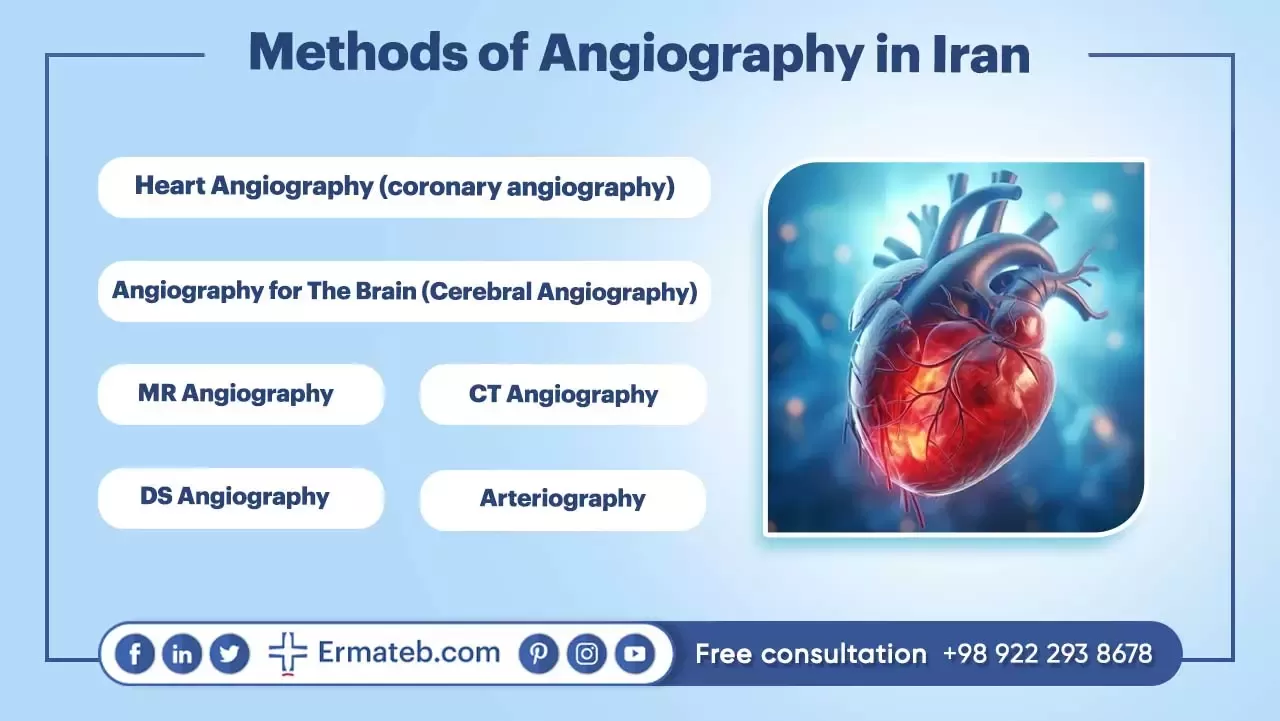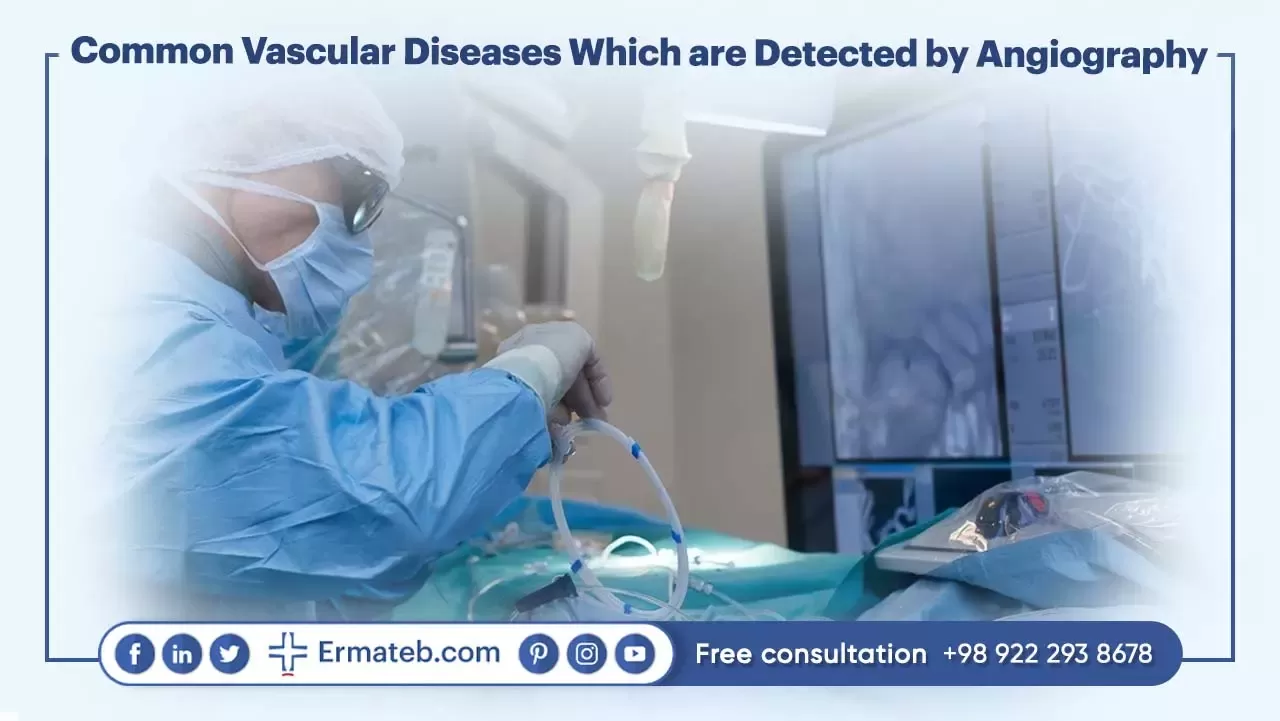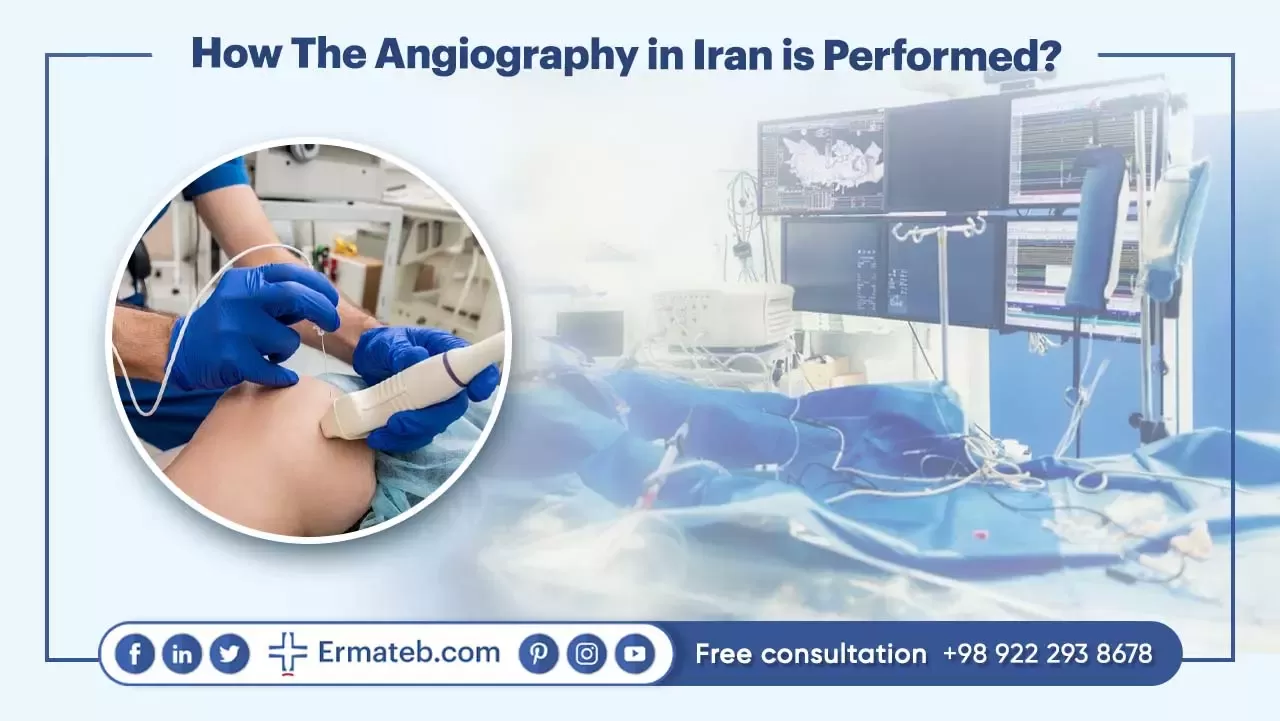The Reasons for Undergoing Angiography
If a patient has problems regarding their blood circulation the doctor may recommend an angiography to determine to cause of the problem.
Angiography can detect arterial problems which might lead to conditions such as: A heart attack, stroke, organ failure and gangrene.
Images generated from angiography can help doctors with planning the patient’s treatment plan so it’s a really significant process.
Methods of Angiography in Iran

Depending on what veins the doctor wants to examine and which methods they’re aiming to use there are different types of angiographies.
The method with the catheter is the conventional one to find the articular abnormalities.
There are also other methods such as MR angiography and CT angiography which the doctor chooses depending on the patient’s situation and symptoms.
Heart Angiography (coronary angiography)
The most common angiography is the coronary angiography which involves examining the coronary artilleries which are a vital part of the vascular system, when a blockage happens in these artilleries it will affect the blood flow which can trigger some dangerous and life-threatening conditions regarding the heart which can be avoided by early diagnostics.
A cardiologist is able to find the blocked or narrowed arteries and recommend the proper treatment.
Angiography for The Brain (Cerebral Angiography)
Brain angiography is done by getting an image of the vessels of the brain, during this type of angiography the cardiologist will spread the contrast material throughout the brain by moving the catheter through the carotid artery with is a vital artery in the neck and by doing so it will be possible to detect any kind of blockage or even a brain tumor.
MR Angiography
Magnetic resonance angiography which is also known as MRA is a type of angiography which is non invasive and uses the same techniques as the MRI diagnostic tool, it uses a magnetic field, uses radio waves and a computer to visualize the blood vessels, in this method the injection of the contrast materials can be skipped and this is beneficial for the patients that are allergic to these materials or have kidney or liver diseases.
CT Angiography
The Computed Tomography angiogram is very similar to a CT scan except this method uses the contrast materials which are injected in the veins for visualizing the blood vessels, CTA shows a more precise result of blood flow compared to MRI or ultrasound.
DS Angiography
The complete name of this method is digital subtraction angiography in which the blood vessels in the brain will be imaged to check their blood flow and find any kinds of complications in them.
Arteriography
It is also known as renal angiography and during it the renal blood vessels will be imaged and any kind of blockage or other complications regarding blood supplying to the kidneys can be detected by it.
The Goal of Angiography
Angiography is one of the most effective ways of identifying abnormalities regarding the vascular system, with the occurrence of some symptoms the doctor might suggest angiography to detect the cause.
The most common signs coronary artery diseases are:
•Nausea
•Fatigue
•Excessive sweating
•Pain in the chest
However, the cerebral artery diseases have signs such as:
•Problems with the eyesight
•Arm and leg weakness
•Headaches
•Nausea
•Dizziness
•Face numbness especially in one side
•Loss of speech and having difficulty with articulating words
Common Vascular Diseases Which are Detected by Angiography

The symptoms may indicate vascular diseases such as:
Atherosclerosis which is the result aging, lack of proper physical activity, unhealthy life style which leads to calcium and fat buildup in the artery and forms a plaque that blocks the blood flow to the brain or the heart and resulting in a heart condition or stroke.
Aneurysm which is the swelling of artery that is the results of the blood vessels walls being weakened.
The last one is arterial dissection which is the abnormal tear in the artery caused by traumas or injuries and can end in a stroke.
How The Angiography in Iran is Performed?

The process starts with the patient being under local anesthesia and then the cardiologist will make small incisions either in the arm or groin and then injects the catheter and connects it to the blood vessel in need of examination, then the contrast material will be injected into the blood flow.
With Xray the contrast will be visualized in the blood flow and makes it possible for the doctor to find the blockage in the vessels.
It is unlikely that you feel any kind of pain through this process which takes within a couple of hours.
It is possible that the doctors find problems in the vessels that can be treated immediately which is usually narrowed or blocked blood vessels which can be treated by angioplasty.
Why Should You Undergo Your Angiography in Iran?

There are many reasons which makes Iran the best place for you to undergo your angiography process such as:
The Highly Skilled Iranian Doctors
The process of angiography is done like all other developed countries and the majority of well-known Iranian cardiologists have all studied in the well-known universities making theme on par with the best surgeons in the United States or European countries in terms of both expertise, experience and having the most modern technologies like at their disposal and one important fact is that Iran is in the top 10 countries in cardiology.
The Tourist Attractions
Many people form others countries yearly come to Iran only for the Iranian tourist attractions, so if you come for your surgery, you will be hitting two heads with one stone and not only you will be undergoing your surgery under the hands of the best doctors you will also enjoy the time you have in Iran with the attractions around the country such as the ancient Persian architectures, the food or even the people’s culture.
The Affordable Cost of Angiography in Iran
Iran is the most affordable country that you can co to for your angiography and it is not due to the lack of quality or the expertise of the doctors, it is quite the opposite, as mentioned the doctors in Iran are among in both expertise and experience the reason for the low cost is the Iranian cheaper currency compared to other countries making Iran the best choice for people to choose.
The price of angiography in Iran compared to other countries start with the most expensive one which is United States with $5000 and goes down with $2700 in Germany, $2000 in India and by far the best one which is $1500 in Iran.
Why Should You Choose Ermateb to Undergo Your Angiography in Iran?

Ermateb is a leading coordinator in Iran and its main goal and focus is to provide the top-notch quality of services to its customers with the best collection of clinics and doctors it has that provide services to you with the most affordable price and giving you the best result.
You can receive more consultation regarding the process of traveling to Iran for your surgery using the online support in the website or WhatsApp
How Do I Prepare for Angiography process?
You should do some things before angiography like any other surgery, you should stop smoking and avoid alcohol, caffeine or any other blood thinning materials and try to do not eat food or drink after the midnight.
Also, people who breastfeed should pump their milk prior to the angiography and the particular reason for that is due to the contrast material remaining in the body after the surgery for about 24 hours past the surgery so it’s not recommended to breastfeed your baby in this period of time.
The Recovery Process of Angiography
After the process if everything goes well you might be able to leave the hospital in a few hours or be advised from your doctor to spend the night in the hospital, where your medical condition will be monitored and your doctor will instruct you on what to do and when to get back to your regular activities when you get home, some important things are such as:
•You should drink plenty of water to get the contrast out of your body faster.
•Press on the area of the incision to prevent it from swelling.
•Regularly taking the prescribed medicines.
•Avoid activities such as exercising.
•Avoid smoking or alcohol and caffeine.
Risks of Angiography
Most of the complications regarding angiography are due to allergic reactions and there are few risks to this process but there are some rare risks and complications that can happen such as:
•Artery being injured
•Infection
•Stroke and problems with the heart
•Infection
•Arrhythmias
•Bleeding
•Damage to kidney
But these things should not happen in the modern clinics with experienced doctors and that is also a reason to choose Iran for angiography so none of these problems happen or at least the risks be as minimal as possible.
Who Performs an Angiography?
An interventional cardiologist can perform an angiography, the angiography of peripheral arteries will be done by vascular surgeons or interventional radiologists and the cerebral angiography will be done by an interventional neurologist.
What Type of Results Do You Get After the Angiography in Iran
Some small blockages might be removed during this process and you might not need another procedure but your doctor might advise to change your life style a bit by more exercising and eating healthier foods.
Some bigger blockages might need an angioplasty to be done to place a stent in the artery to keep it open which is doable during the angiography process.


 Arabic
Arabic
 German
German
 Persian (Farsi)
Persian (Farsi)
 Russian
Russian
 Beauty
Beauty






 Medical
Medical





 Hotels
Hotels
 Hospitals
Hospitals































![Frequently asked question about [name]](/v2tem/images/pages/service/faq-image.webp)
